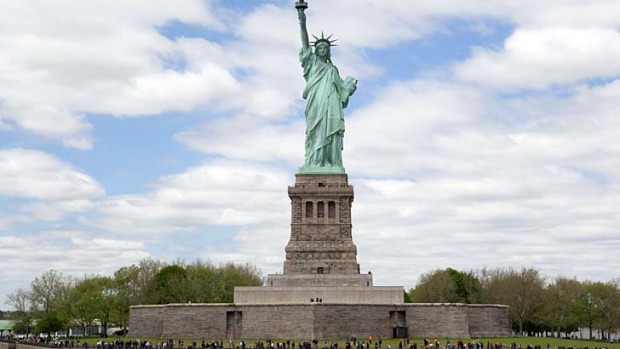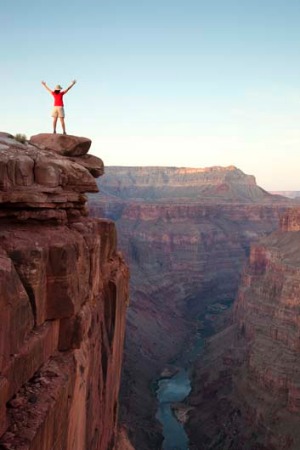
There's a small problem with the USA and Canada – and that is that they're not small. In fact, they're huge. So incredibly huge that you can't even think about "doing North America" in one trip.
This is the home of New York, of Whistler, of Montreal, of New Orleans, of Austin, of Yellowstone, of LA, Miami, Churchill and all points in between. So if this is your first trip to North America, forget about seeing everything. You're going to see a tiny sliver of what the continent has to offer – but even that is a pretty exciting notion.
So what do you choose out of all these options? Do you hit the national parks, enjoy the natural beauty of places like Wells Gray in Canada, or Arches in Utah, or Bryce Canyon, or the Yukon? Or do you stay in the urban areas, enjoying DC, or Vancouver, or San Francisco, or Nashville, or Chicago, or Dallas?

The decision, ultimately, is yours, but my advice is the same: don't attempt to do too much. Slow down. You could spend a fortnight just in New York and not get bored. You could do two weeks in California and not even cover the state.
The secret to travel in the US and Canada (and any country, really) is to identify a few key experiences that you really want to have, and then the rest of the pieces will fall into place around them. Maybe that's outlet shopping, maybe it's skiing, maybe it's art scenes or music or food. Whatever floats your boat – North America has it.
Second piece of advice: don't travel by bus in the US or Canada. Buses in the US, in particular, are pretty horrible affairs that have huge distances to cover. Instead, book early for cheap flights on budget airlines, or travel by train. An even better option, if you have the time, is to hire a car. This is a continent that was built for drivers of automobiles – you'll see more, you'll experience more, you'll meet more people. The roads are good and the cars are huge.
Hire a GPS.
Never, ever be afraid to ask for help in the US or Canada. People are incredibly friendly up there, despite what you might have heard, and will jump at the chance to lend a hand to someone with a weird accent. (While we're on the topic, try not to make fun of Canadians' accents.)
If you're on a budget, stay in hostels – they're of pretty high quality in North America. For longer stays, check out private rental sites like Airbnb. Not only will you save money, but you'll get to experience parts of a city not necessarily designed for tourists.
Brush up on your knowledge of tipping etiquette. This is essential. How much do you tip cab drivers? Or hotel doormen? Or your masseuse? Or the waiter? Tipping in the US and Canada is a minefield of potential errors and embarrassment, with local variations to add to the confusion – the only way through it is to do your research beforehand. And if in doubt, ask someone for help.
Prepare yourself to put on weight. There's a lot more to North American cuisine than burgers and fries – but then, there's also a lot of burgers and fries. The real reason you'll put on weight, however, is that the food is served in enormous portions and is surprisingly good. Actually, really good. And calorific.
Feast on shrimp and grits in the deep south; gorge yourself on poutine in Quebec. Eat pizza in New York, deep dish pizza in Chicago, Tex-Mex in Dallas (hint: if the cheese is yellow, it's Tex-Mex), proper Mexican in California, oysters in the north-east and other seafood in the north-west.
Try the beer. Try any different craft beer you can get your hands on. North America is famous for watery lagers like Bud and Coors, but beer in the US and Canada has undergone a renaissance in the last 10 years or so, with every city specialising in its own "craft brews". For the very best, head to Portland or Seattle.
Remember: it gets cold in the north. Really, really cold. You might be planning your trip for the northern hemisphere winter expecting it to get a little chilly, but if you're heading to the northern states of the US or Canada, we're talking -20 degrees, or -30. That's going to seriously impact on what you can and can't do. (Although it's worth bearing in mind the Canadian maxim: there's no such thing as bad weather, only the wrong clothes.)
See live sport. A day out at an American sporting game – whether it's baseball, basketball, ice hockey or football – is a serious cultural experience, full of quirks and traditions and passion. It's easily worth the exorbitant price (check out sites like Stub Hub for hard-to-get tickets).
See live music. Both the US and Canada have an amazing tradition of live music, from jazz and blues in Chicago, to alternative in Austin, country in Nashville, rock in Memphis, metal in LA, grunge in Seattle and folk in Portland. Every city seems to have a thriving and affordable live scene.
Don't underestimate the greatness of theme parks. Even if you're a grown up, a ride on Space Mountain is a box that needs to be ticked.
Go to Utah – it's vastly underrated. Go to Portland – same story. Go to Aspen – it's not as expensive as you might think, and even in summer it has plenty to offer in the outdoors.
And my final tip for first-time players: pack really, really light. You're going to buy a lot of clothes. The US and Canada are awash with outlet malls and boutiques and department stores, all of which sell clothes and accessories at a fraction of the price you pay in Australia.
The only thing you really need to pack is your credit card.
What are your tips for first-time visitors to the US and Canada? Post your comments below.